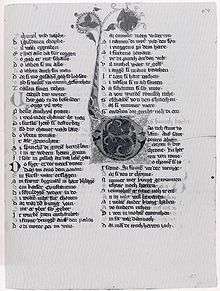Kaiserchronik

The Kaiserchronik (Imperial Chronicle) is a 12th-century chronicle written in 17,283 lines of Middle High German verse.[1][2] It runs from Julius Caesar to Conrad III, and seeks to give a complete account of the history of Roman and German emperors and kings, based on a historiographical view of the continuity of the Roman and German successions. The overall pattern is of a progression from pagan to Christian worlds, and theological disputations stand at the turning-points of the Christianization of the Empire.[3] However, much of the material is legendary and fantastic, suggesting that large sections are compiled from earlier works, mostly shorter biographies and saints' lives.[4]
The chronicle was written in Regensburg some time after 1146. The poet (or at least the final compiler) was presumably a cleric in secular service, a partisan of the Guelphs. However the view that it was written by Konrad der Pfaffe, author of the Rolandslied, has been discredited. Known sources include the Chronicon Wirzeburgense, the Chronicle of Ekkehard of Aura, and the Annolied; the relationship to the Annolied has received particular attention in scholarship, as earlier views of the priority of the Kaiserchronik, or of a shared source, were gradually dismissed.[5] Judging from the large number of surviving manuscripts (twelve complete and seventeen partial), it must have been very popular, and it was twice continued in the 13th century: the first addition, the "Bavarian continuation", comprised 800 verses, while the second, the "Swabian continuation", which brought the poem to the Interregnum (1254–73), consisted of 483 lines. The Kaiserchronik in turn was used as an important source for other verse chronicles in the thirteenth century, most notably that of Jans der Enikel.
The chronicle was first published in full in 1849-54 by Hans Ferdinand Massmann,[6] whose work has been described as an "editionsphilologischer Amoklauf" (a philological editor running amuck),[7] though it does present an impressive collection of analogues. The only critical edition is that of Edward Schröder.[8] There is also a classroom edition of excerpts with parallel translations in English.[9] A project to produce a complete new edition with parallel English translation and at the same time place scans of all manuscripts on-line was announced by the University of London in December 2012.
References
- ↑ Frank Shaw, "Kaiserchronik", Encyclopedia of the Medieval Chronicle, 2010, p. 956.
- ↑ Eberhard Nellmann, "Kaiserchronik", Lexikon des Mittelalters, vol. 5, 1991
- ↑ Graeme Dunphy, "On the Function of the Disputations in the Kaiserchronik", The Medieval Chronicle, 5 (2009), pp. 77-86.
- ↑ Friedrich Ohly, Sage und Legende in der Kaiserchronik, 1940.
- ↑ Mathias Herweg, Ludwigslied, De Heinrico, Annolied: Die deutschen Zeitdichtungen des frühen Mittelalters im Spiegel ihrer wissenschaftlichen Rezeption und Erforschung, Wiesbaden: Reichert, 2002.
- ↑ Massmann, H. F. Der keiser und der kunige buoch, oder die sogenannte Kaiserchronik, Gedicht des 12. Jahrhunderts in 18578 Reimzeilen. 3 vols. (Quedlinburg, Basse, 1849–54)
- ↑ Stephan Müller, Vom Annolied zur Kaiserchronik: Zur Text- und Forschungsgeschichte einer verlorenen deutschen Reimchronik, Heidelberg: Carl Winter 1999. See also the review of this in Modern Language Review, 98 (2003), pp. 755-757.
- ↑ Schröder, E., ed. Die Kaiserchronik eines Regensburger Geistlichen Hanover: Hahnsche Buchhandlung; in Monumenta Germaniae historica. Deutsche Chroniken; I,i
- ↑ James A. Schultz (ed./tr), Sovereignty and Salvation in the Vernacular, 1050-1150. Das Ezzolied, Das Annolied, Die Kaiserchronik vv. 247-667, Das Lob Salomons, Historia Judith. (= Medieval German Texts in Bilingual Editions vol. 1), Kalamazoo MI: Western Michigan University Press, 2000.
Further reading
- Dale, Johanna. "Imperial Self-Representation and the Manipulation of History in Twelfth-Century Germany: Cambridge, Corpus Christi College MS 373", German History, 29:4 (2011), 557–83.
- Rubel, Alexander. "Caesar und Karl der Große in der Kaiserchronik. Typologische Struktur und die translatio imperii ad Francos", Antike und Abendland, 47 (2001), 146–63.
External links
- etext (virginia.edu)